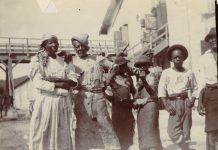Satire on Tulpomania. Monkeys in contemporary 17th century Dutch dress are shown dealing in tulips. A satirical commentary on speculators during the time of “Tulip Mania”, an economic bubble that centered around rare tulip bulbs. At left, one monkey points to flowering tulips while another holds up a tulip and a moneybag. Bulbs are weighed, money is counted, a lavish business dinner is enjoyed. The monkey at left has a list of rare tulips, his sword denotes upper class status. Farther back, a monkey sits like a nobleman astride a horse. One in mid-foreground draws up a bill of sale; the owl on his shoulder symbolizes foolishness and ignobility. Brueghel is not only ridiculing tulip speculators as brainless monkeys, the work is an object lesson for the folly of speculating to such an extent in such a transient thing as a mere bloom. In the denouement at right, a monkey urinates on the now worthless tulips; fellow speculators in debt are brought before the magistrate or weep in the dock. A frustrated buyer brandishes his fists, while at the back right a speculator is carried to his grave. Oil on panel painted circa 1640 by Jan Brueghel the Younger (1601–1678), Flemish painter and draughtsman. Collection: Frans Hals Museum, Haarlem, Netherlands. Public Domain. Source: Wikimedia Commons.
Forside 1637 Satire on Tulpomania. Monkeys in contemporary 17th century Dutch dress are shown dealing in tulips. A satirical commentary on speculators during the time of "Tulip Mania", an economic bubble that centered around rare tulip bulbs. At left, one monkey points to flowering tulips while another holds up a tulip and a moneybag. Bulbs are weighed, money is counted, a lavish business dinner is enjoyed. The monkey at left has a list of rare tulips, his sword denotes upper class status. Farther back, a monkey sits like a nobleman astride a horse. One in mid-foreground draws up a bill of sale; the owl on his shoulder symbolizes foolishness and ignobility. Brueghel is not only ridiculing tulip speculators as brainless monkeys, the work is an object lesson for the folly of speculating to such an extent in such a transient thing as a mere bloom. In the denouement at right, a monkey urinates on the now worthless tulips; fellow speculators in debt are brought before the magistrate or weep in the dock. A frustrated buyer brandishes his fists, while at the back right a speculator is carried to his grave. Oil on panel painted circa 1640 by Jan Brueghel the Younger (1601–1678), Flemish painter and draughtsman. Collection: Frans Hals Museum, Haarlem, Netherlands. Public Domain.
Satire on Tulpomania. Monkeys in contemporary 17th century Dutch dress are shown dealing in tulips. A satirical commentary on speculators during the time of “Tulip Mania”, an economic bubble that centered around rare tulip bulbs. At left, one monkey points to flowering tulips while another holds up a tulip and a moneybag. Bulbs are weighed, money is counted, a lavish business dinner is enjoyed. The monkey at left has a list of rare tulips, his sword denotes upper class status. Farther back, a monkey sits like a nobleman astride a horse. One in mid-foreground draws up a bill of sale; the owl on his shoulder symbolizes foolishness and ignobility. Brueghel is not only ridiculing tulip speculators as brainless monkeys, the work is an object lesson for the folly of speculating to such an extent in such a transient thing as a mere bloom. In the denouement at right, a monkey urinates on the now worthless tulips; fellow speculators in debt are brought before the magistrate or weep in the dock. A frustrated buyer brandishes his fists, while at the back right a speculator is carried to his grave. Oil on panel painted circa 1640 by Jan Brueghel the Younger (1601–1678), Flemish painter and draughtsman. Collection: Frans Hals Museum, Haarlem, Netherlands. Public Domain.



























